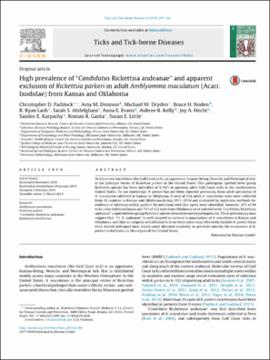| dc.contributor.author | Paddock, Christopher D. | |
| dc.contributor.author | Denison, Amy M. | |
| dc.contributor.author | Dryden, Michael W. | |
| dc.contributor.author | Noden, Bruce H. | |
| dc.contributor.author | Lash, R. Ryan | |
| dc.contributor.author | Abdelghani, Sarah S. | |
| dc.contributor.author | Evans, Anna E. | |
| dc.contributor.author | Kelly, Aubree R. | |
| dc.contributor.author | Hecht, Joy A. | |
| dc.contributor.author | Karpathy, Sandor E. | |
| dc.contributor.author | Ganta, Roman R. | |
| dc.contributor.author | Little, Susan E. | |
| dc.date.accessioned | 2022-04-12T13:52:46Z | |
| dc.date.available | 2022-04-12T13:52:46Z | |
| dc.date.issued | 2015-03-13 | |
| dc.identifier | oksd_noden_highprevalenceofcandidatus_2015 | |
| dc.identifier.citation | Paddock, C. D., Denison, A. M., Dryden, M. W., Noden, B. H., Lash, R. R., Abdelghani, S. S., ... Little, S. E. (2015). High prevalence of "Candidatus Rickettsia andeanae" and apparent exclusion of Rickettsia parkeri in adult Amblyomma maculatum (Acari: Ixodidae) from Kansas and Oklahoma. Ticks and Tick-borne Diseases, 6(3), pp. 297-302. https://doi.org/10.1016/j.ttbdis.2015.02.001 | |
| dc.identifier.uri | https://hdl.handle.net/11244/335188 | |
| dc.description.abstract | Amblyomma maculatum (the Gulf Coast tick), an aggressive, human-biting, Nearctic and Neotropical tick, is the principal vector of Rickettsia parkeri in the United States. This pathogenic spotted fever group Rickettsia species has been identified in 8-52% of questing adult Gulf Coast ticks in the southeastern United States. To our knowledge, R. parkeri has not been reported previously from adult specimens of A. maculatum collected in Kansas or Oklahoma. A total of 216 adult A. maculatum ticks were collected from 18 counties in Kansas and Oklahoma during 2011-2014 and evaluated by molecular methods for evidence of infection with R. parkeri. No infections with this agent were identified; however, 47% of 94 ticks collected from Kansas and 73% of 122 ticks from Oklahoma were infected with ". Candidatus Rickettsia andeanae" a spotted fever group Rickettsia species of undetermined pathogenicity. These preliminary data suggest that " Ca. R. andeanae" is well-adapted to survival in populations of A. maculatum in Kansas and Oklahoma, and that its ubiquity in Gulf Coast ticks in these states may effectively exclude R. parkeri from their shared arthropod host, which could diminish markedly or preclude entirely the occurrence of R. parkeri rickettsiosis in this region of the United States. | |
| dc.format | application/pdf | |
| dc.language | en_US | |
| dc.publisher | Elsevier BV | |
| dc.relation.ispartof | Ticks and Tick-borne Diseases, 6 (3) | |
| dc.relation.uri | https://www.ncbi.nlm.nih.gov/pubmed/25773931 | |
| dc.rights | This material has been previously published. In the Oklahoma State University Library's institutional repository this version is made available through the open access principles and the terms of agreement/consent between the author(s) and the publisher. The permission policy on the use, reproduction or distribution of the material falls under fair use for educational, scholarship, and research purposes. Contact Digital Resources and Discovery Services at lib-dls@okstate.edu or 405-744-9161 for further information. | |
| dc.subject.mesh | Animals | |
| dc.subject.mesh | Arachnid Vectors | |
| dc.subject.mesh | Female | |
| dc.subject.mesh | Humans | |
| dc.subject.mesh | Ixodidae | |
| dc.subject.mesh | Kansas | |
| dc.subject.mesh | Male | |
| dc.subject.mesh | Oklahoma | |
| dc.subject.mesh | Prevalence | |
| dc.subject.mesh | Rickettsia | |
| dc.subject.mesh | Rickettsia Infections | |
| dc.title | High prevalence of "Candidatus Rickettsia andeanae" and apparent exclusion of Rickettsia parkeri in adult Amblyomma maculatum (Acari: Ixodidae) from Kansas and Oklahoma | |
| dc.date.updated | 2022-04-07T14:29:40Z | |
| osu.filename | oksd_noden_highprevalenceofcandidatus_2015.pdf | |
| dc.description.peerreview | Peer reviewed | |
| dc.identifier.doi | 10.1016/j.ttbdis.2015.02.001 | |
| dc.description.department | Entomology and Plant Pathology | |
| dc.description.department | Veterinary Pathobiology | |
| dc.type.genre | Article | |
| dc.type.material | Text | |
| dc.subject.keywords | Amblyomma maculatum | |
| dc.subject.keywords | Rickettsia parkeri | |
| dc.subject.keywords | Rickettsial interference | |
| dc.subject.keywords | Candidatus Rickettsia andeanae | |
| dc.subject.keywords | Vector-Borne Diseases | |
| dc.subject.keywords | Biodefense | |
| dc.subject.keywords | Vaccine Related | |
| dc.subject.keywords | Prevention | |
| dc.subject.keywords | Emerging Infectious Diseases | |
| dc.subject.keywords | Infectious Diseases | |
| dc.subject.keywords | 0605 Microbiology | |
| dc.subject.keywords | 0608 Zoology | |
| dc.subject.keywords | 1108 Medical Microbiology | |
| dc.identifier.author | ScopusID: 7006678201 (Paddock, CD) | |
| dc.identifier.author | ScopusID: 36853000900 (Denison, AM) | |
| dc.identifier.author | ScopusID: 7006207654 (Dryden, MW) | |
| dc.identifier.author | ORCID: 0000-0002-0096-370X (Noden, BH) | |
| dc.identifier.author | ScopusID: 6601968347 (Noden, BH) | |
| dc.identifier.author | ScopusID: 14066256100 (Lash, RR) | |
| dc.identifier.author | ScopusID: 56548855100 (Abdelghani, SS) | |
| dc.identifier.author | ScopusID: 56547909400 (Evans, AE) | |
| dc.identifier.author | ScopusID: 55345976600 (Kelly, AR) | |
| dc.identifier.author | ScopusID: 56548201100 (Hecht, JA) | |
| dc.identifier.author | ScopusID: 6602576318 (Karpathy, SE) | |
| dc.identifier.author | ScopusID: 6701340012 (Ganta, RR) | |
| dc.identifier.author | ScopusID: 26643626200 (Little, SE) | |
